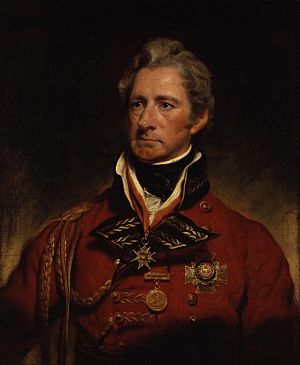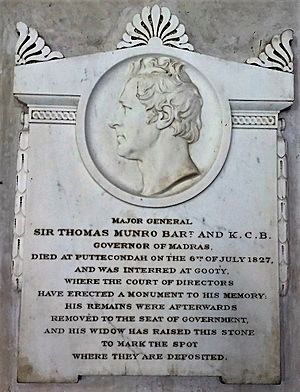Sir Thomas Munro, 1st Baronet facts for kids
Quick facts for kids
Sir
Thomas Munro
KCB Bt
|
|
|---|---|
 |
|
| Governor of Madras | |
| In office 10 June 1820 – 10 July 1827 |
|
| Governor-General | The Marquess of Hastings The Earl Amhurst |
| Preceded by | Sir George Barlow, Bt |
| Succeeded by | Stephen Rumbold Lushington |
| Personal details | |
| Born | 27 May 1761 Glasgow, Scotland |
| Died | 6 July 1827 (aged 65) Pattikonda, Madras Presidency, British India (now: Pattikonda, Kurnool district, Andhra Pradesh) |
| Alma mater | University of Glasgow |
| Awards | Knight Commander of the Order of the Bath |
| Military service | |
| Allegiance | British India United Kingdom |
| Branch/service | Madras Army |
| Years of service | 1779–1827 |
| Rank | Major-General |
| Battles/wars | Second Anglo-Mysore War Third Anglo-Mysore War Third Anglo-Maratha War |
Sir Thomas Munro (1761–1827) was an important Scottish soldier and leader. He worked for the British in India. He was a high-ranking officer in the East India Company Army. Later, he became the Governor of Madras Presidency. He helped shape how the British ruled parts of India.
Contents
Who Was Sir Thomas Munro?
Thomas Munro was born in Glasgow, Scotland, on May 27, 1761. His father, Alexander Munro, was a merchant. Thomas's grandfather had made money in the American tobacco trade. However, the American Revolutionary War caused the tobacco business to fail. This meant Thomas's family lost their wealth.
Early Life and Education
Thomas went to the University of Glasgow. At school, he was known for being honest and kind. He was also very brave and good at sports. He was especially good at boxing. Initially, he was supposed to join his father's business. But in 1779, he decided to become a soldier. He joined the infantry in Madras, India.
A Soldier in India
Thomas Munro served in several tough wars in India. He fought against Hyder Ali from 1780 to 1783. He also fought against Tipu Sultan from 1790 to 1792. After Tipu Sultan's defeat in 1799, Thomas helped bring order to new areas.
He spent seven years learning about land surveys and taxes. He used this knowledge to improve how land was managed. He introduced a system called ryotwari. This system allowed farmers (ryots) to pay taxes directly to the government. This was a big change.
After a break in Britain, he returned to Madras in 1814. He was asked to fix the justice and police systems. In 1817, he became a brigadier-general during the Pindari War. He led a small group of soldiers. He managed to take nine forts and make the area peaceful. For his great service, he was made a Knight Commander of the Order of the Bath in 1819.
Leading Madras as Governor
In 1820, Thomas Munro became the Governor of Madras. He set up new ways of collecting taxes and managing the government. These systems lasted for many years. He is often called the "father of the Ryotwari system". His ideas and advice were written down and used by future leaders.
In 1825, he was given the title of baronet. He cared about education too. In 1826, he helped create a committee for public education. This committee later led to the founding of Presidency College. Sir Thomas Munro died from cholera on July 6, 1827. He was on a tour in the areas he had helped manage.
The Story of Mantralayam
There is a famous story about Sir Thomas Munro in the village of Mantralayam. This village in Andhra Pradesh is home to the saint Raghavendra Swami. In 1800, Sir Thomas Munro was the Collector of Bellary. He was asked to collect taxes from the Math (a religious institution) and the village of Mantralayam.
When his tax collectors couldn't do it, Munro visited the Math himself. He took off his hat and shoes as a sign of respect. The story says that Sri Raghavendraswamy appeared from his tomb. He spoke with Munro about the tax issue. Only Munro could see and hear the saint. Munro then wrote an order that helped the Math and the village. This order was even published in the Madras Government Gazette. It is still kept safe today.
His Famous Statue
A famous statue of Sir Thomas Munro stands in Chennai, India. It was made by Francis Chantrey. The statue shows him sitting proudly on his horse. What's special about it is that the horse has no saddle or stirrups. Some people think this was an oversight by the artist. Others believe it shows Munro's love for riding horses without a saddle.
See also
- Munro Baronets



